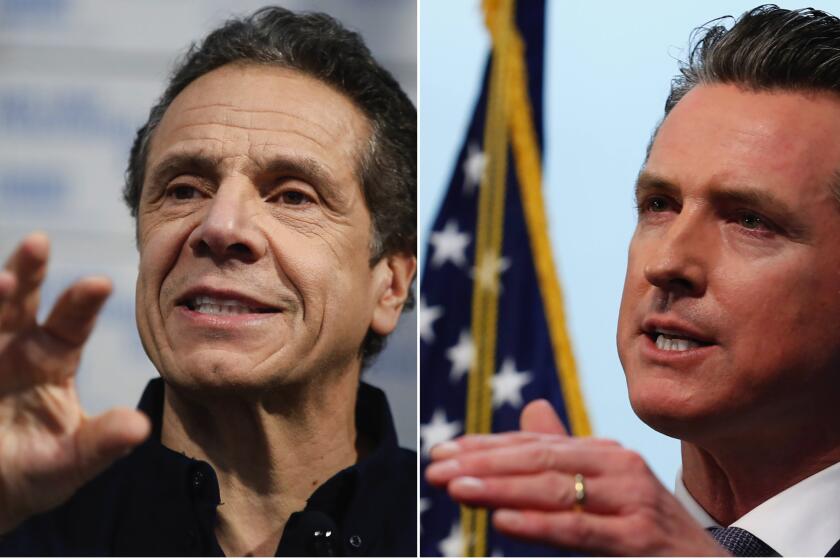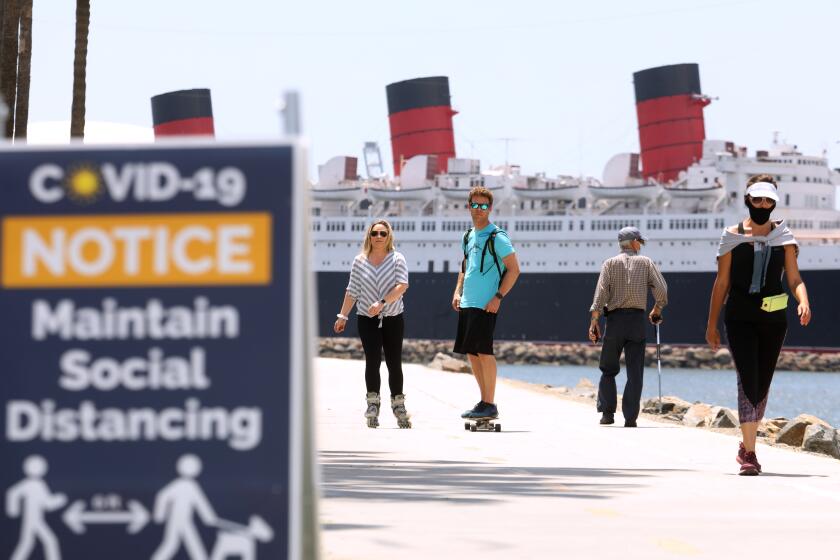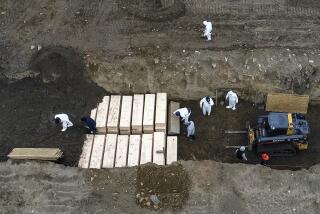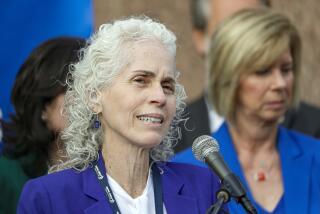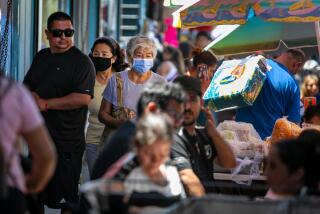Commentary: What L.A.’s future looks like from New York and my coronavirus time machine

- Share via
NEW YORK — Since the second week of March, my self-quarantine routine has become increasingly finite and fixed: the same waking hours, the same couple dozen scrolls through Twitter, the same Zoom meetings, the same late-night Netflix bingeing. The same sameness.
In the late morning, I turn on the television to watch the daily press briefing of my state’s governor, Andrew Cuomo, who offers projections of a pandemic surge that he tells us is still more than two weeks nigh. He is charismatic and clear-spoken. He starts with the numbers, then offers his opinions, when he becomes visibly more emotional. His empathy has made him an overnight political and cultural lodestar. His words are not a vaccine, but they are something. They are a lot, actually.
Hours later, I tune into the daily press briefing of my future state’s governor, Gavin Newsom. He offers projections of a pandemic surge just starting to accelerate, whose peak is likely at least three weeks nigh. He is also charismatic and clear-spoken, though more circumspect than Cuomo. He comes armed with numbers, which he follows with his opinions, delivered with a polish and conviction that stamps him, too, as a high-ceiling politician. His words, they are a lot, too.
But I’ve come to anticipate the California governor’s message. Because I’ve heard it before.
A week before.
In the age of coronavirus, Govs. Andrew Cuomo and Gavin Newsom have become the nation’s truth-tellers and consolers in chief.
I took a position with The Times in February. Today, in fact, was supposed to be moving day after nearly three decades in New York City. From 2,500 miles away, where my family and I will remain for the foreseeable future, I watch the news from California on a sort of eerie tape-delay. Both governors echo the projections of the scientists that place California roughly a week, maybe two, behind New York on the COVID-19 curve. The story of New York, and its largest city — considered to be the epicenter of the public health crisis — and the lessons Los Angeles can learn from us, have become a regular feature of the California news cycle.
Like meteorologists, infectious disease doctors and scientists offer their steady stream of forecasts. It is like watching a weather front moving in reverse, east to west. The projections are informed, but cannot provide the precision everyone craves. Conversations with my West Coast friends and colleagues have taken on an increased urgency and anxiety.
They all want a peek inside this pandemic time machine.
***
My window into New York City isn’t all that different from yours. I restrict my CDC-sanctioned outside time to one family walk and two dog walks a day, generally along Manhattan’s East River and extending no farther than seven city blocks. When people ask me, “What does it look like?” I strike a sunny note first. In a somewhat cruel irony, this March has been, meteorologically speaking, the most glorious I can recall in my three decades here, more closely resembling a Southern California spring than Southern California has enjoyed this month.
But, yes, the streets and bridges are empty and occasionally, too, are many of the shelves. The death toll in New York state is pacing to eclipse that of 9/11 by early next week. A field hospital has been erected in Central Park’s East Meadow, one of the city’s most idyllic spaces. People are visibly scared.
If we can decode the signs, one friend from the Valley asked, would we mind banging a trash can lid when we know what exactly is coming for them?
What they really want to know, however, is “What does it feel like, what does your intuition tell you,” as if I, and other New Yorkers, have an advance scouting report on this apocalyptic opponent. And if we can decode the signs, one friend from the Valley asked, would we mind banging a trash can lid when we know what exactly is coming for them?
This one is trickier. With every passing day here, the virus becomes less of an abstraction and more of, well, life. We all know someone who has been infected, too many know someone who lost a family member, some know hospital workers who, in response to our apologetic pleas for guidance and intel, reply simply: “It’s bad.”
There is an element of dark comedy, as well. For Southern Californians looking to flee the state via automobile, a story: In addition to knowing multiple friends who have been infected (for me, closing in on a dozen as of this writing), I know now of someone who has been pulled over in the neighboring state of Connecticut, not for speeding or driving under the influence... but for driving with a New York license plate. This has become a trend in recent days, with offenders being ordered to self-quarantine when they arrive at their destination.
But there is optimism, a shared sense of danger blunted by a willingness to do what it takes to “conquer the Corona.” Even with my limited eyewitness, I feel confident saying that New Yorkers are taking it, as Southern college football coaches like to say, “serious as a heart attack.” Social distancing — one area, crucially, that California has been ahead of the New York curve — has become as intuitive as not running a red light. Shoppers, six feet apart, thank the men and women at our checkout lines, some stealthily sliding them cash the way they might have, a month earlier, slipped a club bouncer a twenty at 2 a.m. The bros have embraced Dr. Anthony Fauci as if he were Aaron Judge. Residents give their thanks to healthcare workers through neighborhood karaoke. Service is appreciated in a way it hasn’t been since 9/11.
The coronavirus continues to spread rapidly in the Bay Area and Seattle, but so far at a rate slower than in the country’s other hot spots such as New York, New Jersey, Michigan and Louisiana.
***
Last Friday, at precisely seven o’clock in the evening, a crescendo started to build outside our apartment, one that I immediately recognized from the New York Marathon, which on the first Sunday of every November passes by a block away, on 1st Avenue. It was the sustained chorus of excited clapping, whistling and the occasional whoop, actually lots of whoops. New Yorkers, via social media, had appointed the hour as an opportunity to thank and celebrate all the workers who have been our community’s oxygen for close to a month now: the doctors and nurses, the grocery store workers and transit workers, the salaried municipal workers and the volunteers desperate to help in any way they can.
For five, nonstop minutes (a ritual that has continued every night since at the same hour), the chorus continued, as residents began to trickle out of their building. An emergency vehicle came into view, heading north on 1st, and a young woman started to jump in quick anticipatory bursts before unleashing, with full-throated conviction, a message we can all get behind, no coastal tape-delay necessary: We’re going to get through this.
More to Read
Sign up for Essential California
The most important California stories and recommendations in your inbox every morning.
You may occasionally receive promotional content from the Los Angeles Times.
